Fast Fourier Transform animation
by M. Bourne
The Sine Curve y = a sin t
The sine curve occurs naturally when we are examining waves. When waves have more energy, they go up and down more vigorously. We say they have greater amplitude.
Let's investigate the shape of the curve y = a sin t and see what the concept of "amplitude" means.
Have a play with the following interactive.
Sine curve Interactive
Run the animation first (click "Start"). You can change the circle radius (which changes the amplitude of the sine curve) using the green slider.
You can also drag the dot around the circle to create a sine curve (do it slowly).
The scale for this is radians. Remember that π radians is `180°`, so in the graph, the value of `3.14` on the t-axis represents `180°` and `6.28` is equivalent to `360°`.
t = θ = 0
y = 100 sin(0) = 0
Copyright © www.intmath.com
Did you notice?
- The shape of the sine curve forms a regular pattern (the curve repeats after the wheel has gone around once). We say such curves are periodic. The period is the time it takes to go through one complete cycle.
- In the interactive, when the radius of the circle was `50` units then the curve went up to `50` units and down to `-50` units on the y-axis. This quantity of a sine curve is called the amplitude of the graph. This indicates how much energy is involved in the quantity being graphed. Higher amplitude means greater energy.
- The rotation angle in radians is the same as the time (in seconds). See more on radians. All the graphs in this chapter deal with angles in radians. Radians are much more useful in engineering and science compared to degrees.
- When the angle is in the first and second quadrants, sine is positive, and when the angle is in the 3rd and 4th quadrants, sine is negative.
[Credits: The above animation is loosely based on this graph by HubleSoftware.]
Amplitude
The "a" in the expression y = a sin x represents the amplitude of the graph. It is an indication of how much energy the wave contains.
The amplitude is the distance from the "resting" position (otherwise known as the mean value or average value) of the curve. In the interactive above, the amplitude can be varied from `10` to `100` units.
Amplitude is always a positive quantity. We could write this using absolute value signs. For the curve y = a sin x,
amplitude `= |a|`
Graph of Sine x - with varying amplitudes
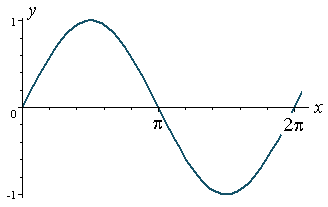
We start with y = sin x.
It has amplitude `= 1` and period `= 2pi`.
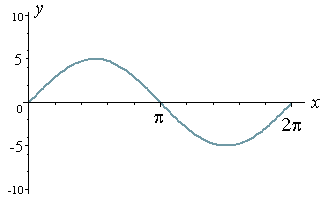
Now let's look at the graph of y = 5 sin x.
This time we have amplitude = 5 and period = 2π. (I have used a different scale on the y-axis.)
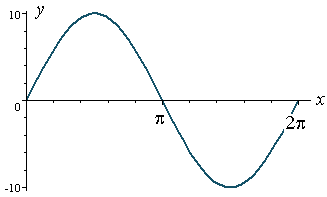
And now for y = 10 sin x.
Amplitude = 10 and period = 2π.
For comparison, and using the same y-axis scale, here are the graphs of p(x) = sin x, q(x) = 5 sin x and r(x) = 10 sin x on the one set of axes.
Note that the graphs have the same period (which is `2pi`) but different amplitude.

Graph of Cosine x - with varying amplitudes
Now let's see what the graph of y = a cos x looks like. This time the angle is measured from the positive vertical axis.
Cosine curve Interactive
Similar to the sine interactive at the top of the page, you can change the amplitude using the slider, and (slowly) drag the dot around the circle to create a cosine curve.
Click "Start" to see the animation.
t = θ = 0
y = 100 cos(0) = 0
Copyright © www.intmath.com
Did you notice?
The sine and cosine graphs are almost identical, except the cosine curve starts at `y=1` when `t=0` (whereas the sine curve starts at `y=0`). We say the cosine curve is a sine curve which is shifted to the left by `π/2\ (= 1.57 = 90^@)`.
The value of the cosine function is positive in the first and fourth quadrants (remember, for this diagram we are measuring the angle from the vertical axis), and it's negative in the 2nd and 3rd quadrants.
Now let's have a look at the graph of the simplest cosine curve, y = cos x (= 1 cos x).
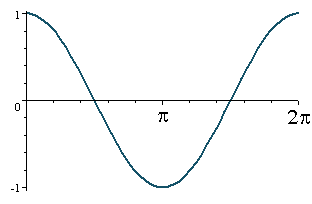
We note that the amplitude `= 1` and period `= 2π`.
Similar to what we did with y = sin x above, we now see the graphs of
- p(x) = cos x
- q(x) = 5 cos x
- r(x) = 10 cos x
on one set of axes, for comparison:
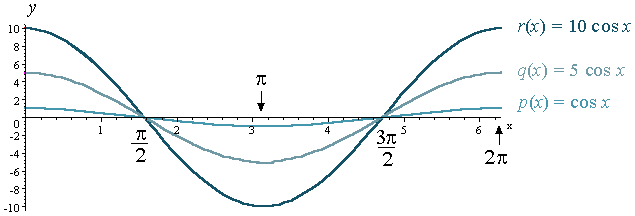
Note: For the cosine curve, just like the sine curve, the period of each graph is the same (`2pi`), but the amplitude has changed.
Exercises
Need Graph Paper?
Sketch one cycle of the following without using a table of values! (The important thing is to know the shape of these graphs - not that you can join dots!)
Each one has period `2 pi`. We learn more about period in the next section Graphs of y = a sin bx.
The examples use t as the independent variable. In electronics, the variable is most often t.
1) i = sin t
2) v = cos t
3) i = 3 sin t
4) E = −4 cos t
